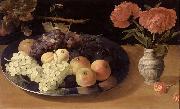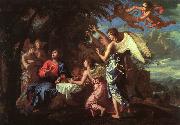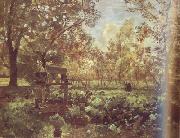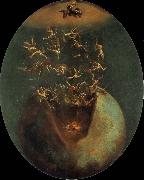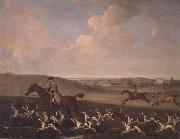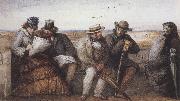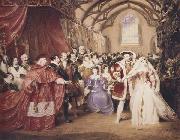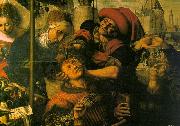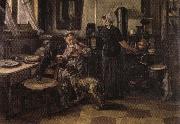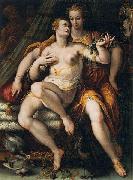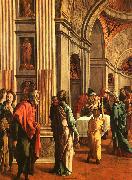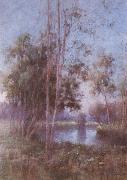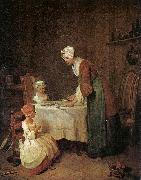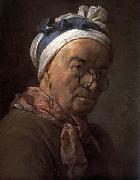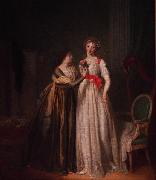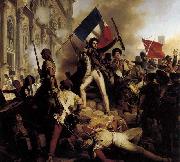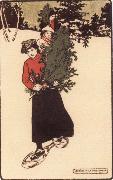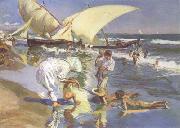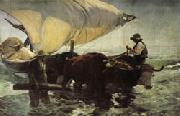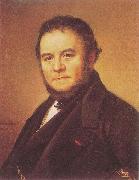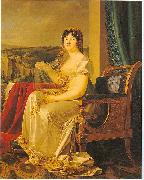|
|
|
|
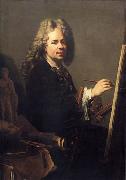 |
Jacob van Schuppen
|
|
Born in Fontainebleau, France, as the son of the painter-engraver Pieter van Schuppen, he worked in the Netherlands before moving to Vienna. He was taught to paint by his father and his uncle Nicolas de Largilliere.
In 1719 he was registered in Luneville, but he moved in the same year to Vienna where he became court painter. In 1725 he was appointed director of the Academy of Fine Arts Vienna, when it was refounded by Emperor Charles VI as the k.k. Hofakademie der Maler, Bildhauer und Baukunst (Imperial and Royal Court Academy of painters, sculptors and architecture). |
|
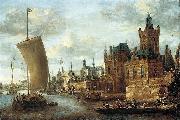 |
Jacobus Storck
|
|
(1641 - c.1700) was a Dutch Golden Age marine painter.
Storck was born and died in Amsterdam. According to Houbraken he was the brother of the marine painter Abraham Storck who painted views of the Rhine and inland ships, but who was not as gifted.
According to the RKD he was the second son of the marine painter Johannes Sturckenburgh, younger brother of the marine painter Johannes Storck and older brother of Abraham. Signed works by him are dated 1664-1687. He sometimes signed JA Storck, which since 1963 has been interpreted as a work by both Jacobus and Abraham together.
|
|
|
|
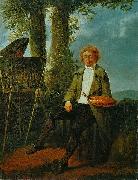 |
Jacques Sablet
|
|
Jacques Sablet (1749 - 1803) was a Swiss painter. Son of a decorator and gilder from Lausanne, he studied with his father before moving to Paris in 1772; there he worked with Joseph-Marie Vien for three years. When in 1775 Vien was named director of the French Academy in Rome, Sablet accompanied him there. His ambition was to be a history painter, but facing competition from Jacques-Louis David and Pierre Peyron, among others, and lacking solid academic training, he could win no commissions. Instead he turned to portraiture , genre painting, and landscape painting. Most of his genre scenes depicted the city's everyday life and customs of the Campagna. Sablet shared a studio with history painter Hubert Drouais and was friends with Simon Denis. He fled to Florence in 1793 with the rise of anti-French sentiment in the Papal States, but perhaps because of the competition he would face there from Louis Gauffier he soon returned to Paris. |
|
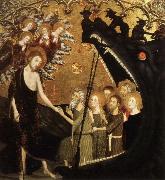 |
jaime serra
|
|
(birth unknown-died after 1405) was a Catalonian painter. Serra was influenced heavily by a Sienese style introduced by Ferrer Bassa. His altarpiece The Holy Spirit can be found in the Manresa cathedral.
This Catalan biographical article is a stub. You can help Wikipedia by expanding it.
This Spanish painter article is a stub. You can help Wikipedia by expanding it. |
|
|
|
|
|
 |
jakob seisenegger
|
|
Jakob Seisenegger (1505 ?C 1567) was an Austrian painter used by Charles V. He won international fame for his use of full-length poses in his portraits, creating a model used by future artists, such as François Clouet. His portrait Emperor Charles V with Hound (1532), currently resides in the Kunsthistorisches Museum Vienna. |
|
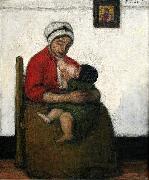 |
Jakob Smits
|
|
Jakob Smits or Jacob Smits (Rotterdam, 9 July 1855 - Achterbos (Mol), 15 February 1928) was a Dutch-Flemish painter. He was born as son of a decorator. Jakob studied in Rotterdam at the academy and helped its father in the decoration business. From 1873 up to 1876 het studied at the Academy in Brussels, and afterwards also in Munich (1878-1880), Vienna (1880) and Rome (1880). In 1882, Jakob married his cousin Antje Doetje Kramer. They settled in Amsterdam, where Smits worked as a painter. He carried out, among other things, tasks for the museum Boijmans-Van Beuningen in Rotterdam. Out of the marriage of Jakob and Antje two children, Theodora and Annie, were born. In 1884, the couple divorced.
Jakob Smits moved to Blaricum and in Haarlem becomes director of the Nijverheids- en Decoratieschool (E: Industry and Decoration school). He gets to know Albert Neuhuys, a painter of the The Hague School, and together they make excursions to Drenthe and the Campine in Belgium. Jakob Smits becomes impressed by the Campine landscape and he establishes himself in 1888, definitively in Achterbos (Mol). He pays 2,000 Belgian francs for a small farm which he develops to his Malvinahof. In the same year he marries Malvina Dedeyn, the daughter of a Brussels lawyer, who is disinherited because of this marriage. Smits lives in poverty while he works tirelessly for what he will call my simple work, symbolic, poetic and real. In 1897, he received a gold medal for his exhibitions of large water-colour paintings on a gold background in Munich and Dresden. He also paints a lot of portraits, especially of Malvina and of their children Boby, Marguerite and Kobe. In 1899 destiny strikes: in a few days time he loses his daughter Alice and his wife. In 1901, Smits marries with Josine Van Cauteren. In the same year he holds his first individual exposition in Antwerp. There he obtains much praise of colleagues and critics but finds no buyer for his work. The exhibited work De vader van de veroordeelde (E: the father of the convict) was acquired later that year by the Museum of Brussels.
Smits financial situation improved somewhat, but his family was put heavily on the test. In 1903 both his parents were ruined by a robbery and as a resulthe now had nine family members to maintain. At the request of the municipal authorities of Mol, Smits in 1907, arranged an international exhibition of artists who came to paint landscapes in Mol and its surroundings. The artist Paula Van Rompa-Zenke belonged to the arranging committee. There were no less than 68 painters participating, with Germans, Dutch, and Americans coming to Mol. The term Molse School was born. In 1910, Smits published an album with 25 engravings, which was dedicated to Queen Elisabeth. In 1912, the young Dirk Baksteen became a student of Smits.
In 1914, Smits stopped with the production of art work. He became President of the Comite voor hulpverlening en voedselvoorziening van het canton Mol (E: Committee for assistance and food supplies of the canton Mol). After World War I he continued his work with a totally new vision and style as engrave and painter. |
|
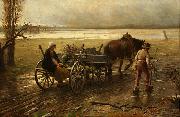 |
Jakub Schikaneder
|
|
(February 27, 1855, Prague - November 15, 1924, Prague) was a Czech painter, known for his soft paintings of the outdoors, often lonely in mood. The National Gallery in Prague held an exhibition of his paintings from May 1998 until January 1999.
He was descended from Urban Schikaneder, the elder brother of the librettist Emanuel Schikaneder.
|
|
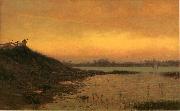 |
James Augustus Suydam
|
|
(1819-1865) architect, lawyer, and artist; as an artist was considered one of the premier Luminism painters. He is widely known as an American landscape painter and one of the leading members of the Hudson River School.
James Augustus Suydam was descended from an old New York Dutch merchant family. He graduated from New York University (then the University of the City of New York), and began his career as a businessman but turned a significant portion of his energies to painting, studying under famed artist and portrait painter Minor C. Kellogg. At the age of thirty he was elected to the Century Association.
One of the "regulars" who gathered to paint at North Conway, New Hampshire, he exhibited Conway Meadows at the New York Athenaeum and Boston Athenaeum. He opened his studio at the noted 10th Street Studio Building, New York City, in 1858. The following year he was elected an honorary professional member in the prestigious National Academy of Design, which granted him full membership in 1861. He died suddenly in North Conway at the age of 46.
James Suydam was described by his friend, the accomplished artist Sanford Robinson Gifford as a "thoroughly educated and accomplished man. " In addition to his work as an artist, which he began only after working in law and architecture, he was widely read and well-versed in history, philosophy, and the sciences. His work as a landscape painter reflects this breadth of knowledge and reveals Suydam as a deeply spiritual individual. Using his familiarity with science, Suydam reduced nature to calm, clean, planar forms, and then distorted proportional relations so that God's creations loomed superior over the work of man.
The National Academy has most of his works such as Paradise Rocks (1865), and the Taft family's Taft Museum also holds works. The Taft also has a podcast website for this artist.
A painting of Gifford's from 1859 which Suydam, according to a report, "donated to the [National] academy in 1865," became the subject of a deaccession controversy at the Academy in late 2008.
|
|
 |
James Gay Sawkins
|
|
(1806-1878) was an artist who was born in 1806 in Yeovil, Somerset, England. At the age of 14, he moved to Baltimore, Maryland with his family, where he made his living painting miniature portraits on ivory. He lived in Cuba from 1835 to 1845 and visited Hawaii from January, 1850 to June, 1852. After working in Australia, he returned to England in 1855. Sawkins died in 1878 in Turnham Green (near London), England.
The Honolulu Academy of Arts, Mission House Museum (Honolulu, Hawaii) and the National Library of Australia (Canberra) are among the public collections holding works by James Gay Sawkins.
|
|
 |
James Jebusa Shannon
|
|
(1862 - 1923), Anglo-American artist, was born in Auburn, New York, and at the age of eight was taken by his parents to Canada.
When he was sixteen, he went to England, where he studied at South Kensington, and after three years won the gold medal for figure painting. His portrait of the Hon. Horatia Stopford , one of the queen's maids of honour, attracted attention at the Royal Academy in 1881, and in 1887 his portrait of Henry Vigne in hunting costume was one of the successes of the exhibition, subsequently securing medals for the artist at Paris, Berlin, and Vienna.
He soon became one of the leading portrait painters in London. He was one of the first members of the New English Art Club, a founder member of the Royal Society of Portrait Painters and in 1897 was elected an associate of the Royal Academy, and RA in 1909. His picture, "The Flower Girl", was bought in 1901 for the National Gallery of British Art.
|
|
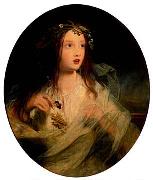 |
James Sant
|
|
(1820-1916) was a British painter specializing in portraits, and a member of the Royal Academy. Sant was born in Croydon and taught by John Varley and Augustus Wall Callcott. He lived to the age of 96 and produced an astonishing number of canvases for exhibition at the Academy, some 250 of them, from 1840 through 1904. He was elected to the RA in 1870, and in 1872 Sant was appointed Principal Painter in Ordinary (official portraitist) to Queen Victoria and the royal family. Sant resigned from the RA in 1914 to "make room for younger men." His work can be found at the Tate Gallery.
His brother George Sant (1821 - 1877) was a landscape painter. His sister Sarah Sherwood Clarke (who married Frederick Clarke, Superintendent and later Secretary of the LWS Railway) was an artist of great talent, but all that remains of her work is a collection of 48 different views of Scotland from 1854; these were exhibited for the first time at the "Watercolours & Works on Paper Fair" in London in February 2010.
|
|
|
|
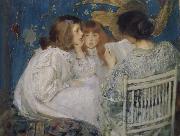 |
James Shannonc
|
|
born in the United States and moved to England in 1878 where he trained at South Kensington
1862-1923
|
|
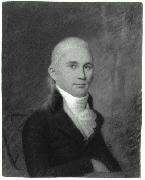 |
James Sharples
|
|
(1751 or 1752 in Lancashire - 26 February 1811 in New York ) was an English portrait painter and pastelist, who moved to the United States in 1794. He first exhibited at the Royal Academy in 1779.
James was first intended for the Catholic priesthood, but became an artist instead.Sharples headed a family of successful portrait artists, including his third wife Ellen Sharples. He had four children, George by his first wife, Felix Thomas Sharples from his second marriage (c. 1786- after 1823), and James Sharples Jr.(c. 1788-1839) and daughter Rolinda Sharples (1793-1838) with this third wife, Ellen. Felix, James Jr. and Rolinda joined the family enterprise at ages 17, 15, and 13 respectively. Before marrying Ellen Wallace, James had been active in Bristol, Liverpool and Bath, where he taught drawing. Ellen was a lady of French extraction who had relations in America. The family left for the United States in 1796, but, according to Ellen's diaries, their ship fell into the hands of the French, and for seven months the family spent time in Brest, near Cherbourg. Landing in New York, James quickly became popular for his small portraits in pastel and his miniatures. From 1796 to 1801 he worked mainly in Philadelphia and New York, securing portrait commissions. The family traveled throughout New England region as itinerant portrait painters, looking for work and making inexpensive copies from the originals portraits they had made of popular and well-known figures, such as George Washington and James Madison.
|
|
|
|
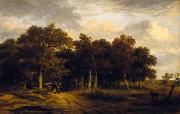 |
James Stark
|
|
(November 19, 1794 - March 24, 1859) was an English landscape painter of the "Norwich School".Stark was born in Norwich, the youngest son of distinguished dyer Michael Stark (1748-1831, Scottish), and showed a talent for art from an early age. He was educated at the Grammar School where he was friends with John Berney Crome. He was then apprenticed for 3 years to John Berney's father, distinguished landscape artist John Crome, from 1811.
In that same years he exhibited work at the Norwich Society of Artists (being elected a member in 1812,) and his work "A view on King Street river, Norwich" was shown by the Royal Academy, London. In 1814 he moved to London, exhibiting at the British Institution between 1814-18, winning a prize of £50 in 1818. In 1817 he entered the Royal Academy as a student, and eventually began to receive commissions for his work.
Ill health forced Stark to return to Norwich after only 2 years study. There he devoted himself to painting the scenery around the city and executed a series of paintings of Norfolk rivers which were eventually engraved and published in 1834. In 1821 he married Elizabeth Younge Dinmore (d. 1834-35).
In 1830, he again settled in London, taking up residence in Chelsea, and exhibited at the British Institution, Royal Academy and Society of British Artists. In 1839, he moved to Windsor, painting many pictures of the scenery of the Thames, but moved back to London in 1849 in order to further his son's education in art.
Stark died at Mornington Place, Camden, London, in March 1859.
Stark's only son, Arthur James Stark (1831-1902), born in Chelsea, London, became a landscapes and animal painter. On a few of his father's pictures he was employed to draw the cattle.
|
|
|
|
|
|
|
|
|
|
|
|
Jan Stanisławski
|
|
(June 24, 1860, Olshana near Korsun - January 6, 1907, Krakew) was a Polish modernist painter, art professor, originator and member of various art groups and societies.
Initially, he studied mathematics at Warsaw University (1879 - 1882), and subsequently at the Imperial Technical Institute in St Petersburg.
He began to learn painting in the so called Drawing Class (which later gave rise to the School of Fine Arts) in Warsaw under Wojciech Gerson. In 1883, he enrolled in the School of Fine Arts in Krakew. In 1885, he continued his studies in Paris under Charles Emile Auguste Durand. While based in Paris, he travelled much, visiting Italy, Spain, Switzerland, Germany, Austria, and also Ukraine.
His early works were exhibited at the inauguration of the Salon du Champ-de-Mars in Paris in 1890 and at the Friends of the Arts Society in Krakew in 1892. In the 1890s, he travelled extensively and his sketchbooks filled up with drawings from Berlin, Dresden, Prague, Krakew, and various places in Ukraine. Together with Julian Fałat, he painted the landscape parts of Napoleones Army Crossing the Berezina, a panorama by Wojciech Kossak.
In 1897, he initiated and helped organise the Separate Exhibition of Pictures and Sculptures at Krakewes Cloth Hall. That year, he become a teacher of landscape painting at the School of Fine Arts in Krakew, and in 1906 - after the school was upgraded to an academy in 1900 - was granted full professorship and also taught at Teodor Axentowiczes Private School of Painting and Drawing for Women and at Teofila Certowiczes Art School for Women in Krakew.
He co-founded the "Sztuka" ("Art") Society of Polish Artists in Krakew in 1897. Later he became Deputy Chairman and finally Chairman of that society, and showed his works at numerous exhibitions organised by it. In 1898, he became a member of the Viennese Secession, and his works were exhibited among theirs in 1901, 1902 and 1905. In 1901, he became a founding member of the Polish Applied Arts Society. He worked in the Wawel Castle Reconstruction Committee and was involved in the activities of the Green Balloon (Zielony Balonik) Cabaret.
After his death, two exhibitions were opened at the Palace of Art in Krakew in November 1907, one to show 154 of his oil paintings, as well as drawings and watercolours, and the other to present the works of his numerous outstanding students.
|
|
|
|
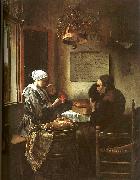 |
Jan Steen
|
|
Dutch Baroque Era Painter, ca.1625-1679 |
|
|
|
|
|
|
|
|
|
 |
January Suchodolski
|
|
(September 19, 1797 - March 20, 1875) was a Polish painter and Army officer.
Suchodolski was born in Grodno and was the brother of Rajnold Suchodolski.
From 1832 to 1837 Suchodolski studied in Rome, where he was a pupil of Horace Vernet. Suchodolski became known for his history and battle paintings.
He died in Bojmie (near Siedlce).
|
|
|
|
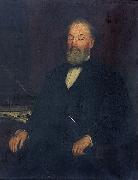 |
Jean Paul Selinger
|
|
Jean Paul Selinger (1850-1909) and Emily Selinger (1848-1927), husband and wife, had summer art studios at the Glen House and the Crawford House. Born in Boston, Jean Paul studied at the Lowell Institute and in 1875 he went to Germany to study at the Munich Academy with Wilhelm Leibl. Upon returning, he opened an art studio in Providence, Rhode Island, and married Emily McGary, also an artist. The Selingers had a studio in Boston and a summer art studio at the Glen House, Pinkham Notch in the 1880s. In 1894 the Selingers moved into the former studio of Frank H. Shapleigh at the Crawford House. In August 1894 the Selingers accepted an invitation to serve on the board of judges for a North Conway Coaching Parade Committee. Jean Paul painted numerous portraits, still-life paintings, and White Mountain landscapes. Emily painted both watercolors and oils of local flora.
Jean Paul was a member of the Boston Art Club. He exhibited at the National Academy of Design in 1880 and the Paint and Clay Club in Boston in 1889. |
|
|
|
 |
Jean Simeon Chardin
|
|
(2 November 1699 - 6 December 1779) was an 18th-century French painter. He is considered a master of still life, and is also noted for his genre paintings which depict kitchen maids, children, and domestic activities. Carefully balanced composition, soft diffusion of light, and granular impasto characterize his work.
Chardin was born in Paris, the son of a cabinetmaker, and rarely left the city. He lived on the Left Bank near Saint-Sulpice until 1757, when Louis XV granted him a studio and living quarters in the Louvre.
Chardin entered into a marriage contract with Marguerite Saintard in 1723, whom he did not marry until 1731. He served apprenticeships with the history painters Pierre-Jacques Cazes and Noël-Nicolas Coypel, and in 1724 became a master in the Academie de Saint-Luc.
According to one nineteenth-century writer, at a time when it was hard for unknown painters to come to the attention of the Royal Academy, he first found notice by displaying a painting at the "small Corpus Christi" (held eight days after the regular one) on the Place Dauphine (by the Pont Neuf). Van Loo, passing by in 1720, bought it and later assisted the young painter
|
|
|
|
|
|
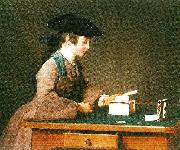 |
jean-simeon chardin
|
|
Jean-Baptiste-Simeon Chardin, född 2 november 1699 i Paris, död 6 december 1779 i Paris, var en fransk målare. Mästare på stilleben och genrebilder.
Chardins blygsamma läggning, personliga stil och valet av motiv från medelklassens vardagsliv försenade hans succe i Bouchers och Fragonards Frankrike, men 1728 invaldes han i Franska akademin samtidigt som hans genrebilder genom gravörernas försorg blev populära.
När 1700-talets hovkonst inte längre var populär, steg Chardins popularitet. De enkla kompositionerna, de ensamma gestalterna i form av köksflickor i arbete eller barn försjunkna i sina lekar, påverkade målare som på 1800-talet målade vardagsmotiv. Manet influerades starkt av den lugna klarheten i Chardins stilleben, liksom Courbet hade påverkats före honom. |
|
|
|
|
|
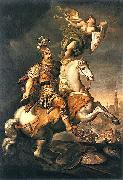 |
Jerzy Siemiginowski-Eleuter
|
|
(ca. 1660 - ca. 1711) was a prominent Polish painter and engraver of the Baroque, court painter of king John III Sobieski and a Polish-Lithuanian noble. He is considered one of the most accomplished painters of Classical Baroque in Poland, who joined in his works classical theory with genuine motives.
|
|
|
|
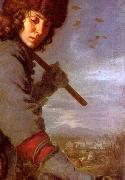 |
Joachim von Sandrart
|
|
(12 May 1606 - 14 October 1688) was a German Baroque art-historian and painter, active in Amsterdam during the Dutch Golden Age.
Sandrart was born in Frankfurt, but the family originated from Mons. According to Houbraken (who used his Teutsche Akademie as a primary source), he learned to read and write from the son of Theodor de Bry, Johann Theodoor de Brie and his associate Matthäus Merian, but at age 15 was so eager to learn more of the art of engraving, that he walked from Frankfurt to Prague to become a pupil of Gillis Sadelaar (also known as Aegidius Sadeler of the Sadeler family). Sadelaar in turn urged him to paint, whereupon he travelled to Utrecht in 1625 to become a pupil of Gerrit van Honthorst, and through him he met Rubens when he brought a visit to Honthorst in 1627, to recruit him for collaboration on part of his Marie de' Medici cycle. Honthorst took Sandrart along with him when he travelled to London. There he worked with Honthorst and spent time making copies of Holbein portraits for the portrait gallery of Henry Howard, 22nd Earl of Arundel.
Making all of those copies only served to arouse more curiosity in the young adventurer, and in 1627 Sandrart booked a passage on a ship from London to Venice, where he was welcomed by Jan Lis (whose Bentvueghels bent name was "Pan"), and Nicolaas Ringnerus. He then set out for Bologna, where he was met by his cousin on his father's side Michael le Blond, a celebrated engraver. With him, he crossed the mountains to Florence, and from there on to Rome, where they met Pieter van Laer (whose bent name was "Bamboccio"). Sandrart became famous as a portrait-painter. After a few years he undertook a tour of Italy, traveling to Naples, where he drew studies of Mount Vesuvius, believed to be the entrance to the Elysian fields described by Virgil. From there he traveled to Malta and beyond, searching for literary sights to see and paint, and wherever he went he paid his way by selling portraits. Only when he was done traveling did he finally return to Frankfurt, where he married Johanna de Milkau.
Afraid of political unrest and plague, he moved to Amsterdam with his wife in 1637.
|
|
|
|
|
|
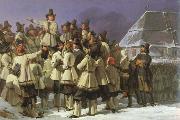 |
johan gustaf sandberg
|
|
Johan Gustaf Sandberg, född 1782, död 1854, var målare; han var professor i teckning vid Konstakademien från 1828, och direktör där 1845?C1853.
Sandberg ägnade sig främst åt historiemåleri, med motiv ur nordisk mytologi och svensk historia. Hans främsta verk inom detta område är kalkmålningarna över Gustav Vasa i Uppsala domkyrka. Han målade också en mängd porträtt.
Sandberg blev 1794 elev i konstakademins principskola och 1801 i antikskolan, lärde samtidigt musik och klaverspelning och tjänade pengar genom lektioner och genom arbete på kungliga teaterns dekorationsmålarverkstad. Under den följande tiden slöt han sig till den opposition mot akademin, som hade sin medelpunkt i "Sällskapet för konststudium". Tvisten med akademin lade sig snart, Sandberg valdes till ledamot 1821 och blev ordinarie professor 1828. Däremot hade han aldrig tillfälle att göra den för äldre tiders konstnärer obligatoriska studieresan till södern.
Han utförde teckningarna till praktverket "Ett år i Sverige" (1827 -35) med bilderna graverade under Christian Didrik Forssells ledning och texten skriven av Anders Abraham Grafström. Under upprepade sommarvistelser på Säfstaholms slott målade Sandberg folktyper och folkdräkter.
Åtskilliga porträtt utförde Sandberg för det praktfulla "Galleri af utmärkta svenska lärde, vetenskapsidkare och konstnärer", som han utgav 1835?C42 (100 porträtt, litograferade av J. Cardon).
|
|
|
|
|
|
|
|
|







